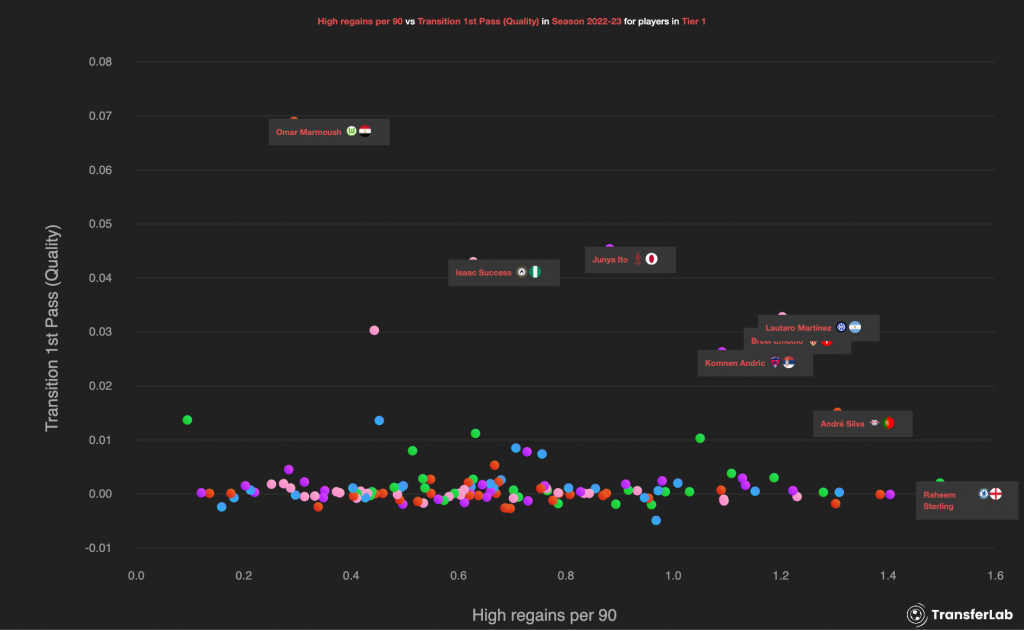Alex Stewart looks at two new metrics that shed light on transitional play
Transitions are key in football. These are the moments when the game switches either from attack to defence, or defence to attack. Our focus here will be on transitions to attack. One team is now on the front foot, regaining possession and able to attack the opposition at their moment of greatest vulnerability (because their own defence is not set up to defend; they, too, are in transition). With a greater emphasis on pressing – an organised attempt to regain possession by actively targeting the ball, opposition players, or space with pressure – transitions are not only occurring more frequently, but can also afford greater opportunities to attack.
With this in mind, Analytics FC have added two new metrics to our TransferLab data scouting platform, to better reflect the importance of transitions in the game.
Transition Pass Security % is the pass completion percentage for the first pass after regaining possession. Transition 1st Pass (quality) is the value of that first pass upon regaining possession. TransferLab’s GDA model values every action for how if affects a team’s chances of scoring or conceding a goal; in essence, a positive Transition First Pass (quality) value for the first pass after regaining possession means that the passer’s team is now more likely to score.
Using TransferLab’s player plot tool, we can have a look at Premier League midfielders to see which players do well in transition from defence to attack. Using the two metrics, Transition Pass Security % vs Transition 1st Pass (quality), we can assess who turns defence into attack securely and progressively.

As the graph above shows, Spurs’ Rodrigo Bentancur and Granit Xhaka of Arsenal are safety-first, but also contribute slightly positively to their team’s chances of scoring. At the other end of the spectrum, Liverpool’s Harvey Elliott is much less accurate, which probably means riskier, but also advances his team considerably. The player who best balances security and progression is the league’s outstanding transitional midfielder, Moises Caicedo, while Cheick Doucoure of Crystal Palace, who was outstanding in an over-performing Lens team last season, and Brighton’s Alexis MacAllister also rise above the mass of midfielders.
Expanding our parameters by both time and space, we can look at Tier 1 midfielders over the last 12 months (Tier 1 is Europe’s top five leagues).

Napoli‘s Piotr Zielinksi is the outstanding performer here (he also rates well for counter-pressing recoveries per 90), who offers a high degree of progression with a reasonable degree of safety. Clermont’s Saif-Eddine Khaoui is well above average for progression but is also extremely secure, while Lyon’s Maxence Caqueret stands out for both too. It’s interesting, given the conception that the Bundesliga is extremely transitional, how no BL player stands out (BL players are shown in red here, with Ligue 1 in pink, PL in green, and La Liga in blue, while purple is Serie A). Dijbril Sow is probably the Bundesliga’s best all-round safety vs progression transitional midfielder, according to these two metrics.

One further obvious area of interest is when one considers high regains and then transitional pass. While this comparison doesn’t indicate whether a high regain immediately precedes a transitional pass, players who rate highly for volume and quality are likely to be especially effective counter-pressing forwards.

Looking at strikers in Tier 1 in 2022/23, Wolfsburg’s Omar Marmoush sticks out for the quality of his transitional passing (he is, in fact, the best rated in TransferLab for any Tier 1 player this season), while players like Isaac Success, Junya Ito, Lautaro Martinez, Breel Embolo, and Komnen Andric all show up well. It’s also worth highlighting Raheem Sterling, who’s ability to win the ball back is incredible, but who seems to do extremely little of progressive value with the ball in transition.

Header image: Imago/Jaques Feeney/Offside














